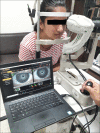Noninvasive ocular surface analyzer as an adjunct in diagnosis and estimating prevalence of meibomian gland dysfunction: Hospital-based comparative study
- PMID: 35502020
- PMCID: PMC9333042
- DOI: 10.4103/ijo.IJO_2245_21
Noninvasive ocular surface analyzer as an adjunct in diagnosis and estimating prevalence of meibomian gland dysfunction: Hospital-based comparative study
Abstract
Purpose: To assess the role of noninvasive ocular surface analyzer (OSA) in workup of meibomian gland dysfunction (MGD) and to estimate hospital-based prevalence of MGD using this objective device.
Methods: The study recruited 113 consecutive participants attending the ophthalmology outpatient department of a tertiary care hospital. All participants were administered a symptom questionnaire. Participants underwent a comprehensive ocular examination, including slit-lamp biomicroscopy and meibomian gland expression. Lipid layer thickness (LLT), noninvasive tear breakup time (NIBUT), tear meniscus height (TMH), and meibomian gland loss (MGL) were assessed using OSA. The presence of either or both reduced/absent meibum secretion and cloudy to toothpaste-like secretion was diagnosed as MGD.
Results: Prevalence of total MGD was 57.52% (95% confidence interval [95% CI]: 48.3%-66.8%) and that of symptomatic MGD was 42.5% (95% CI: 33.2%-51.7%). Prevalence of total and symptomatic MGD was highest in those aged ≥50 years (P < 0.001 and P = 0.004, respectively). Computer vision syndrome increased the odds of symptomatic MGD (odds ratio [OR]: 4.3). NIBUT and MGL significantly differed in MGD and non-MGD groups (P = 0.023 and P < 0.001, respectively). LLT significantly differed between asymptomatic and symptomatic cases (P = 0.033). MGL >25% increased the odds of having MGD (OR: 19.1). Significant negative correlations were observed between MGL and NIBUT (P = 0.04) and between MGL and LLT (P = 0.02). MGL demonstrated the highest diagnostic accuracy for MGD (AUC = 0.827, sensitivity = 75.4%, specificity = 85.4%, cut-off value: ≥26%).
Conclusion: MGD is a common disorder in adults attending the ophthalmology outpatient services of a tertiary eye care hospital. Incorporating noninvasive OSA in clinical practice can aid in rapid and reliable measurements of MGD-related parameters.
Keywords: Dry Eye; meibomian gland dysfunction; meibomian gland loss; meibomian glands; ocular surface analyzer.
Conflict of interest statement
None
Figures


Comment in
-
Commentary: Revisiting meibomian gland dysfunction - Could noninvasive ocular surface analyzer be a comprehensive solution to the universal dilemma?Indian J Ophthalmol. 2022 May;70(5):1546. doi: 10.4103/ijo.IJO_3028_21. Indian J Ophthalmol. 2022. PMID: 35502021 Free PMC article. No abstract available.
References
-
- Tong L, Chaurasia SS, Mehta JS, Beuerman RW. Screening for meibomian gland disease: Its relation to dry eye subtypes and symptoms in a tertiary referral clinic in Singapore. Invest Ophthalmol Vis Sci. 2010;51:3449–54. - PubMed
-
- Kim J, Hwang Y, Kang S, Kim M, Kim TS, Kim J, et al. Association between exposure to smartphones and ocular health in adolescents. Ophthalmic Epidemiol. 2016;23:269–76. - PubMed
-
- Schein OD, Tielsch JM, Munõz B, Bandeen-Roche K, West S. Relation between signs and symptoms of dry eye in the elderly A population-based perspective. Ophthalmology. 1997;104:1395–401. - PubMed
-
- Viso E, Rodríguez-Ares MT, Abelenda D, Oubiña B, Gude F. Prevalence of asymptomatic and symptomatic meibomian gland dysfunction in the general population of Spain. Invest Ophthalmol Vis Sci. 2012;53:2601–6. - PubMed
-
- Siak JJK, Tong L, Wong WL, Cajucom-Uy H, Rosman M, Saw SM, et al. Prevalence and risk factors of meibomian gland dysfunction: The Singapore Malay eye study. Cornea. 2012;31:1223–8. - PubMed
MeSH terms
LinkOut - more resources
Full Text Sources

